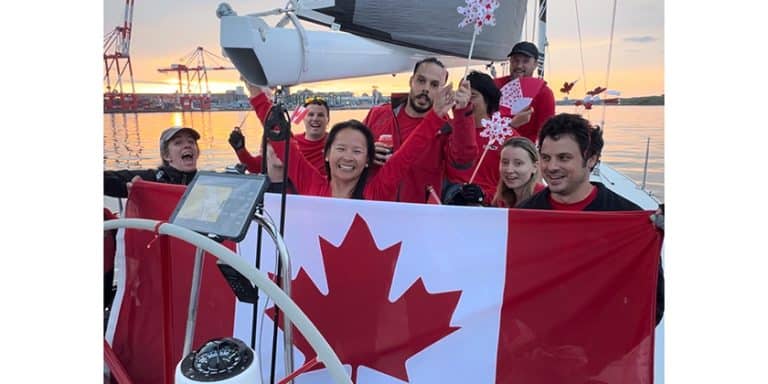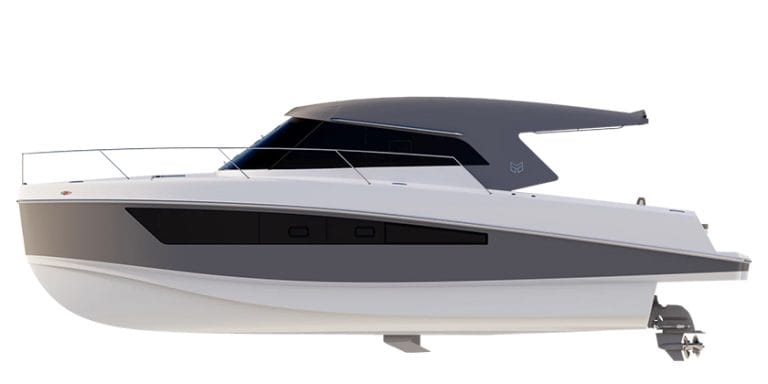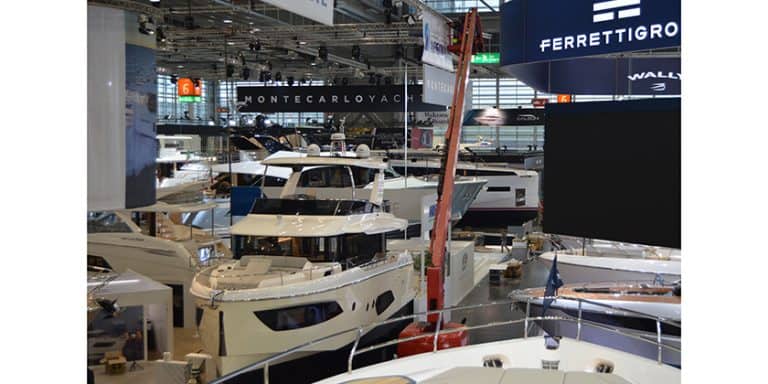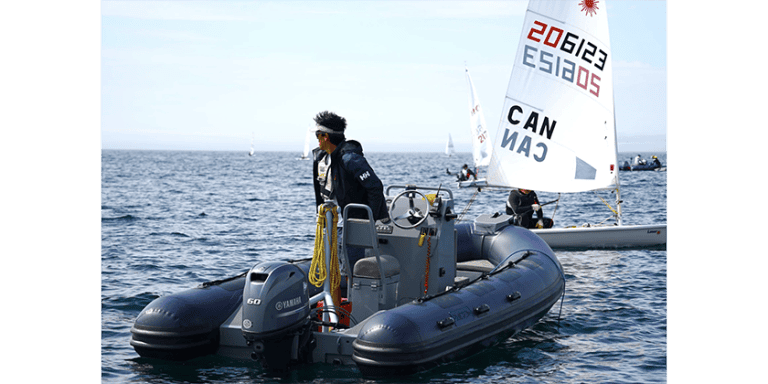How DO you make a boat go FAST!
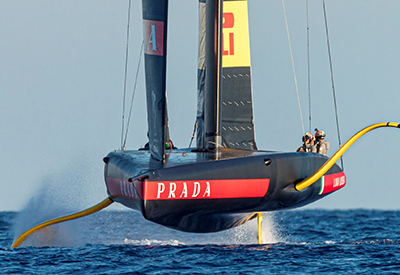
Dec 3, 2020
It’s a bird, no it’s a plane, no it’s actually a boat, just a unique vessel that flies like a plane. The 2021 America’s Cup AC75s and IMOCA boats (like the ones currently going around the world in Vendée Globe) are foiling monohulls capable of speeds four times that of the true wind, with boat speeds approaching 50 Kts. They are but the latest and fastest of hydrofoil boats from trans-channel ferries to Olympic catamarans and probably soon to wakeboarding boats.
How do they do this? In a nutshell foils and an aerodynamic hull.
Step 1 is the foils. Foils are long, slender, very strong arms that rotate up into the air or down into the water. As the yacht accelerates the foils generate lift, raising the yacht up out of the water, drastically decreasing it’s drag, with an immediate and substantial increase in speed. While exotic looking, the foil-arm wings are also lead ballasted. When the vessel is foiling this allows the Leeward foil in the water to generate lift, and the windward foil arm raised in the air to generate a righting moment to balance the heeling forces generated by the sails. As does an airplane wing, the foil arm wings have computer-controlled flaps that keep the vessel “flying” in a smooth path.
When at dock, the AC75 has both foils in the water tucked close to the vessel taking up minimum space. As it’s towed out to the course, the foils are extended out either side somewhat, acting like stabilizers. Once in open water and free of the tow, the sails are trimmed to power the boat, the vessel speeds up, the foil wings generate lift, and the vessel (all 6.5 tons and 75 feet of it!) rises up, lifting the hull clear of the water.
In maneuvers and rough sea conditions the vessel may use both foils in the water, however due to reduced drag it will fly faster on just one. As the vessel speeds up, it gains stability allowing the vessel to fly on just the leeward foil and the inverted “T’ shaped rudder. The windward foil is then raised right up providing over 1 ton of weight to counteract the heel from the sails. This configuration gives the vessel its fastest speed.
 – the wings on the foils are critical
– the wings on the foils are critical
As per the America’s cup design rules, in order to reduce the design and testing of the AC75’s unique features, Luna Rossa Prada Pirelli team has built all foiling arms and their controlling mechanisms as one-design components for all the participants. The wings on the ends of the foil arms, however, are part of each syndicate’s design. They will be looking for minimal drag and maximum maneuverability. You want to go fast but also be able to get around the corners.
Axis of evil
Balancing on the foils is tricky and unique to a monohull. In a regular monohull, when the vessel heels it does so parallel to the fore/aft axis of the boat. Similarly in a catamaran, any healing is done along the fore/aft axis of one of the hulls. Not so with a foiling monohull. When normally flying, the vessel is suspended between the foil out one side and the rudder at the back. This results in a very canted axis the vessel is rotating around. When the boat heels to leeward the bow rises and when the boat heels to windward the bow drops. This is in addition to any compounding effects from the change of righting moment as the windward foil rises or dips. It’s quite a balancing act to keep the boat level in varying wind conditions. Bearing away is one of the most challenging maneuvers. This has led to some interesting sky leaps or nosedives while the teams have been practicing. However the monohulls seem better able to survive these antics then their foiling catamaran counterparts.
 Step 2 – hull design.
Step 2 – hull design.
America’s Cup designers can do what they like as long as they adhere to a basic box specifying max length, beam and draft. There is no keel or centreboard to reduce drag, as resistance in the water will hinder foiling. More time will be spent in the air than in the water so aerodynamics becomes more important than typical hydrodynamics.
Do you end up wanting a vessel that’s fastest through the water and up on her foils or do you want a vessel that’s the fastest in flight? Both would be good, but Murphy strikes again and says because of the laws of hydrodynamics and aerodynamics you can have one or the other but not both. A hull with flat sections and a centre V shaped skeg can reduce the time taken from displacement mode to flying mode. A smooth flat bottom hull will be faster in flight. In displacement mode the majority of the drag from the waves at the air-water interface. Getting up onto the foils as quickly as possible to reduce this drag is critical.
The teams are taking different approaches. The Italians and New Zealanders are banking on their skiff type hulls with a secondary step to get them out of displacement mode and into the air as quickly as possible. While hoping to predominantly do this once at the race start, they realize vessel stability relies on speed and there will be unplanned drop downs. A fluky breeze, sudden maneuvering, or a slow tack may find them back in the water. That will be costly, taking time to come back up to speed while your competitor charges by at 50 knots. The Italians and New Zealanders hull shape should help it recover quickly from a splash down but its less streamlined shape will create a little more aerodynamic drag when foiling.
The UK INEOS and American Magic teams have designed their hulls with smooth flat bottoms with less aerodynamic drag to be faster when up in the air. However that air optimized streamlined bottom has a large wetted surface and will stick to the water slowing the boat down quickly if it drops out of flight.
Part of the hull design rationale is to maintain an aerodynamic seal under the boat while in the water to prevent high pressure on the windward side leaking to the leeward side reducing efficiency. This maximizes the forward driving force to accelerate the boat quickly to allow the foils to lift the vessel. As the boat rises there is a dramatic reduction in water drag and the vessel accelerates even more quickly.
The designs also attempt have a clean shape on the upper surface of the deck to lower aerodynamic drag and to what ever degree possible act like a lifting surface. The apparent wind over the deck is high enough that reducing drag is not the only concern. Any lift generated can help lift the entire vessel out of the water.
These vessels are complex racing machines with over 18,000 parts and have upwards of 140,000 man hours invested in design and construction. It will be fascinating to see how each performs.
 CYOB’s Boat Nerd, Mike Wheatstone, has enjoyed sailing since he was in his mid teens. He bought his first boat in 1980, a Shark. With the growing family’s 2-foot-itis saw upgrades to a Grampian 26, CS34 and finally a Hunter36. A retired electrical engineer, Mike and his wife spend summers on the Hunter (Dragonfyre) and winters in the Caribbean on their Leopard 43 cat (Peregrine).
CYOB’s Boat Nerd, Mike Wheatstone, has enjoyed sailing since he was in his mid teens. He bought his first boat in 1980, a Shark. With the growing family’s 2-foot-itis saw upgrades to a Grampian 26, CS34 and finally a Hunter36. A retired electrical engineer, Mike and his wife spend summers on the Hunter (Dragonfyre) and winters in the Caribbean on their Leopard 43 cat (Peregrine).
Got a question or comment for Mike? Please send them along to cyonboard@kerrwil.com and put “Nerd” in the subject line.

